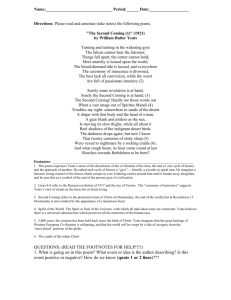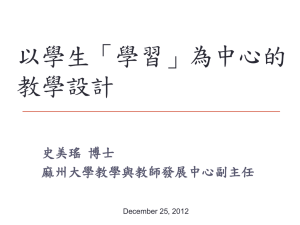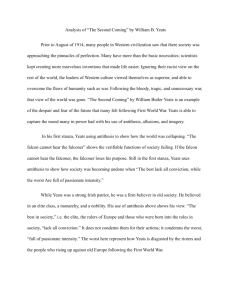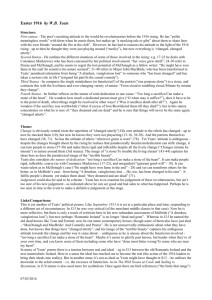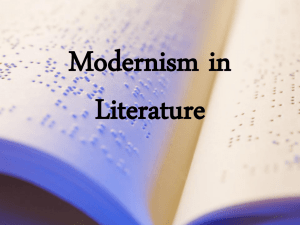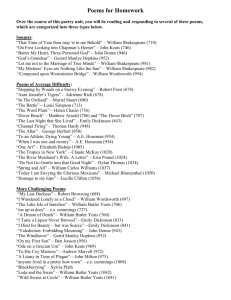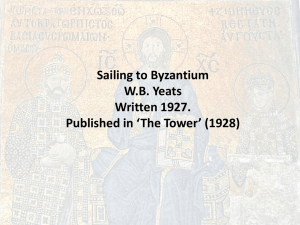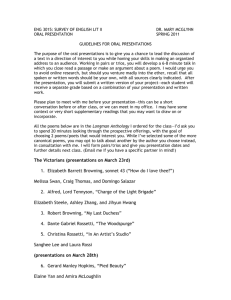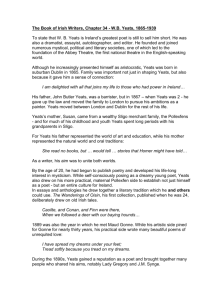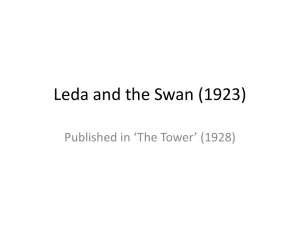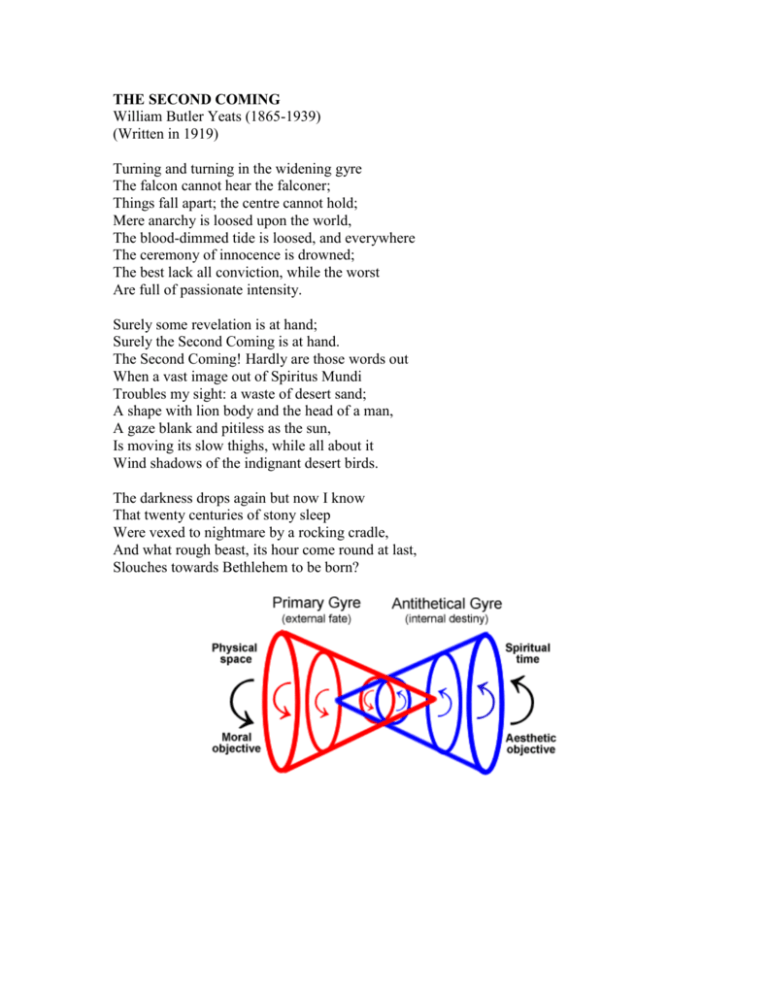
THE SECOND COMING
William Butler Yeats (1865-1939)
(Written in 1919)
Turning and turning in the widening gyre
The falcon cannot hear the falconer;
Things fall apart; the centre cannot hold;
Mere anarchy is loosed upon the world,
The blood-dimmed tide is loosed, and everywhere
The ceremony of innocence is drowned;
The best lack all conviction, while the worst
Are full of passionate intensity.
Surely some revelation is at hand;
Surely the Second Coming is at hand.
The Second Coming! Hardly are those words out
When a vast image out of Spiritus Mundi
Troubles my sight: a waste of desert sand;
A shape with lion body and the head of a man,
A gaze blank and pitiless as the sun,
Is moving its slow thighs, while all about it
Wind shadows of the indignant desert birds.
The darkness drops again but now I know
That twenty centuries of stony sleep
Were vexed to nightmare by a rocking cradle,
And what rough beast, its hour come round at last,
Slouches towards Bethlehem to be born?
The Second Coming was written in 1919 in the aftermath of the first World War. The
above version of the poem is as it was published in the edition of Michael Robartes and
the Dancer dated 1920 (there are numerous other versions of the poem). The preface and
notes in the book contain some philosphy attributed to Robartes.
This printing of the poem has a page break between lines 17 and 18 making the stanza
division unclear. Following the two most similar drafts given in the Parkinson and
Brannen edited edition of the manuscripts, I have put a stanza break there. (Interestingly,
both of those drafts have thirty centuries instead of twenty.) The earlier drafts
also have references to the French and Irish Revolutions as well as to Germany and
Russia.
Several of the lines in the version above differ from those found in subsequent versions.
In listing it as one of the hundred most anthologized poems in the English
language, the text given by Harmon (1998) has changes including: line 13 (": somewhere
in sands of the desert"), line 17 ("Reel" instead of "Wind"), and no break between the
second and third stanza.
Source: http://www.potw.org/archive/potw351.html
Yeats's System
A Vision (1925; revised 1937) outlines a system that was supposedly dictated by supernatural
commentators speaking through Mrs.Yeats. [See the comments on automatic writing in your text.]
It turns its back on the mainstream twentieth-century orthodoxies of Christianity, Marxism, and
psychoanalysis.
Yeats envisioned life as patterned after The Great Wheel (a wheel with twenty-eight spokes
representing the twenty-eight phases of the lunar month) instead of the more common astrological
wheel of twelve houses.
Every soul (and every civilization) passes through all twenty-eight phases of the wheel. Each
phase is labeled and illustrated. Phase 19, the "Assertive Man," is illustrated by Byron. Phase 17,
"Daimonic Man," includes Dante, Shelley, Landor, and Yeats himself. However, for Phase I and
its exact opposite, Phase 15, which represent absolutely pure types, Yeats saw no human
counterparts. One historical revolution of the wheel takes two thousand years, and each
successive revolution mounts spirally toward the Great Year (26,000 years) which will break out
of the wheel altogether.
Yeats also saw that each individual was composed of warring elements, and that this mingling of
opposites held true for each country, and each era. He represented this conjunction of opposites as
two interpenetrating cones ("gyres"):
A cross section of these ceaselessly turning cones will reveal the mingled aspects of a specific
individual, and, no two cross sections will ever prove identical. Thus, each person can be seen to
possess some characteristics that are directly opposite to his dominant nature. A person whose
nature intersects the diagram midway would suffer a paralysis of action or feeling because he
would be pulled equally in two opposite directions.
In the Great Wheel, each of Yeats's twenty-eight basic personality types is so arranged that it
faces its direct opposite, the personality most different from it. This opposite is its Mask. For
every personality there is a Mask, but the objective, primary phase personalities should ignore
their Masks or else they will be frustrated and destroyed. The subjective or artistic personalities
all must choose a Mask to wear, but they are faced with two to choose from, a True Mask and a
False, and it is necessary that they choose correctly.
(The above is taken from Martin S. Day's History of Enqlish Literature: 1837 to the Present,
Garden City: Doubleday, 1964, 245-46. The graphics are mine.)
The following provides a quick look at Yeats's Faculty Psychology:
The Four Faculties
Characteristics
Will (The Is)
will, drive, natural ego
Mask (The Ought)
emotion, desire; what one wishes to
become; what one reverences
Creative Mind
(Thought, the
Knower)
intellect; innate universal Ideas; the
consciously constructive mind
Body of Fate
(Object of Thought;
the Known)
environment (both physical and mental)
The Four Faculties are the result of the four memories of the Daimon (daemon) or the Ultimate
Self of the Man:
The Will (The Is) or the natural ego of man is shaped out of the Daimon's
memory of all the events of his present life, whether consciously remembered or
not.
The Mask (The Ought), the object of desire or idea of the good, is shaped out of
the Daimon's memory of the momenta of exaltation in his past lives.
The Creative Mind (Thought, the Knower) is shaped out of the Daimon's
memory of ideas--or universals--displayed by actual men in past lives or their
spirits between lives.
The Body of Fate (Object of Thought; the Known) is the series of events forced
upon him from without and is shaped out of the Daimon's memory of the events
of his past incarnations.
The Four Principles are the powers that guide the Four Faculties and deal with life from death
to birth:
Husk
Passionate Beauty
Spirit
Celestial Body
Clearly I don't expect you to understand all of this in great detail. However, in looking at the
concept of the gyre and at the basic oppositions in his Faculty Psychology, you should recognize
Yeats's awareness of the dual nature of existence that we saw in the Romantics, with their
concern for "the reconciliation of opposites."
©
Scott Foll 2000. All rights reserved.
http://images.google.com/imgres?imgurl=http://aliscot.com/ensenanza/4033/gyre.gif&imgrefurl=http://aliscot.com/ensenanza/4033/vi
ctorian/yeats_sys.htm&usg=__l8qd9ONHR_Fa2wx8blDvPhUtmEE=&h=201&w=377&sz=15&hl=en&start=2&tbnid=UfIYR6vFMu
7RnM:&tbnh=65&tbnw=122&prev=/images%3Fq%3Dyeats%2Bgyres%26gbv%3D2%26hl%3Den

